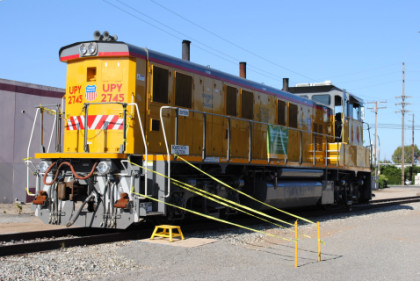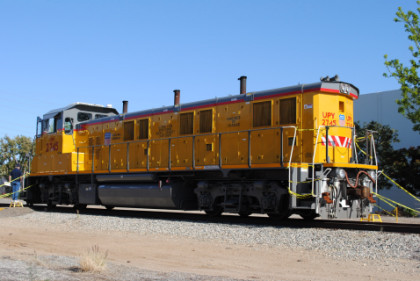Back in 2010 I went to Brea for an event that happened there only once in history.


Union Pacific UPY 2745 at Brea Railroad Days 2010 on May 1, 2010 was my only train on this line.
We jump back to the present where Elizabeth and I picked up Marty Smith for another morning of railroad trail in Brea this time.
Brea Pacific Electric Trail informationWhat was once a railroad and train depot has transformed into a 50-acre linear park that traverses the City across four miles. "The Tracks" features a two-way bike trail, with a separate pedestrian path, nine fitness stations, two bike repair stations, seating areas with shade structures, benches, drinking fountains and restrooms. There are also interpretive signs along the trail that offer information and photographs on the area's history, butterfly gardens and low water landscaping.
The Tracks has been in the works for many years. A volunteer community task force worked to gather and analyze information as an early part of the process. Outreach began in May 2009 and led to three separate visioning workshops and a community survey. An outreach report on that effort was compiled in 2010.
Pacific Electric HistoryWork on the line began under the Los Angeles Interurban Railway between 1906 and 1908 with Pacific Electric assuming control and completing the line between 1909 and 1911. The route was not originally intended to start passenger service until a connection to Corona was complete. Despite that, the line opened as a branch of the Whittier Line by 1911 with service reaching Stern on November 12. Service beyond Yorba Linda was abandoned after August 1, 1930. The route ceased service after January 22, 1938 due to low ridership.
This line was originally constructed by the Pacific Electric in the early 1910s, and served the citrus groves and oil fields in northern Orange County. It crossed the AT&SF Olinda branch at grade at a station called Carlton. This PE line paralleled the south side of Imperial Highway for the easternmost three miles. Eventually the oil fields closed and the citrus groves were replaced with houses, schools, churches, businesses, etc. The line was cut back to a freight customer, Brea Chemical, during the PE days (before the SP formally merged the PE in 1965).
In the 1990s, after SP was merged into the UP, the line was cut back another mile and a half, to Brea. The line currently ends just west of State College Boulevard in Brea. In Yorba Linda, at the corner of Imperial Highway and Lemon Drive, a yellow caboose is on display along with some baggage carts. (The caboose's identifying information has been painted over.) Until 2009, a stretch of track was visible at the intersection of Imperial Highway and Rose Avenue, but that remnant has now been removed.
Our WalkWe parked off State College Blvd and then the three of us walked to the trail.
The trail marker for this trail, Brea Tracks.
We crossed State College Blvd and started our westward walk of the trail. Now we will walk to Brea Blvd.
The westward walk to Brea Blvd.
You cross Brea Blvd.
A compass point built into the trail.
There are many sign boards along the trail, but no Pacific Electric history.
The west end of the rail trail in Brea.
Elizabeth and Marty at the west end.
Chris and Marty at the west end.
Looking back from where we had come.
These stairs takes you to the non-railroad trail.
An excellent wall on the way going east.
A railroad spur was passed on back to State College Blvd.
You cross State College Blvd. Now we will complate the trail to East Birch Street.
You walk under the Orange Freeway.
You are nearing East Birch Street.
Marty at East Birch Street.
Chris at East Birch Street.
Looking east towards Yorba Linda.
We have all completed the Brea Tracks Trail.
We walked back to the car and drove back to our apartment in Santa Ana. This completes the Orange County Rail Trails.
| RETURN TO THE MAIN PAGE |